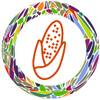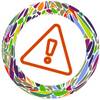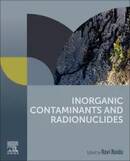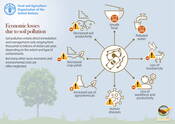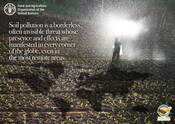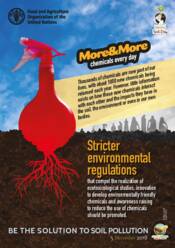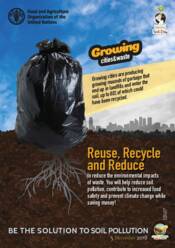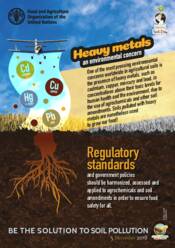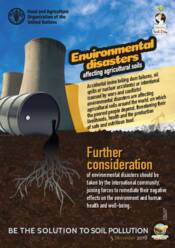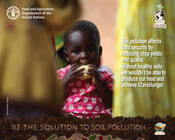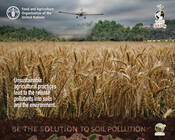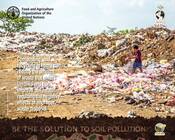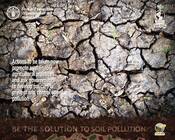
国际土壤污染合作组织 (INSOP)
国际土壤污染合作组织 (INSOP)
国际土壤污染合作组织(INSOP)的宗旨是阻止土壤污染,并最终实现全球零污染的目标。为此,国际土壤污染合作组织致力于提高对土壤污染防治全生命周期的认识,包括污染评估、土壤修复、对环境和人类健康的影响、土壤生态系统功能服务的提供等。INSOP还旨在加强预防土壤污染的技术能力和立法框架,并促进污染土壤可持续修复和风险管控的经验技术交流。更多信息请联系:[email protected] and the: GSP-Secretariat.
INSOP的职能和职责
污染是全球最大的环境问题之一,对环境和人类健康构成重大风险 (粮农组织,2015). )。地方一级的行动可以产生超越国界的影响。因此,需要采取联合和协调行动来防止土壤污染,并控制、管理和修复被污染的土壤。世界各地的许多利益相关者都在为预防、控制和修复土壤污染进行不同方面的工作,但政府、政策制定者、土地使用者、学术界和社会之间缺乏有效的全球协调。.
该网络的建立是对扩大全球努力的紧急回应,并将使所有利益相关者进行有效、协调和包容的沟通,以实施土壤污染的全球行动议程,迈向一个零污染的世界。
INSOP的使命是支持和促进共同努力,减少土壤污染的风险,并对已受污染的地区进行有效的修复
INSOP通过以下方式为全球服务。:
• 为土壤污染知识的产生和传播提供一个国际平台;
• 促进交流以可持续方式管理受污染土壤的良好做法、实用和科学知识以及创新解决方案;
• 在政府、学术界、私营部门和社会之间建立跨学科的合作联系,以促进开发更清洁、更可持续的解决方案和消费选择;以及
•通过现有组织之间的协调,加强技术和工艺能力。.
国际土壤污染网络下设六个工作组(WGs),每个工作组负责具体活动。加入我们的工作组网络,以实现以下目标:
1. 土壤污染评估
- 倡导制定全球统一方法,包括标准操作程序 (SOP),以确定和测量土壤污染物;以及
- 在关于农业土壤和其他土地利用,倡导建立一个土壤污染物阈值的全球数据库,重点关注重金属和农药
2. 土壤污染空间分布
- 生成有关受污染土壤分布和潜在污染源的空间数据集,对政策决策将至关重要。工作组的活动有待 2024 年批准。
3. 土壤污染监测与管理
倡导更好地理解有关预防、监测和/或修复土壤污染的国家法律文书。
4. 污染土壤的可持续修复和风险管控
- 倡导发展国家能力,加强污染土壤修复和可持续管理方面的技术转让
5. 农田污染与食品安全
- 倡导促进将土壤污染纳入 "一个健康 "方法和全球健康观察站;以及
6. 土壤和水污染
- 加强了解土壤和水污染物的环境和生态毒理学风险、环境归宿和行为。工作组的活动有待 2024 年批准。
如需登记您的兴趣,请提交以下表格
INSOP由一名主席和一名副主席协调各项活动并监督工作计划的执行。主席和副主席的任命在INSOP年度会议上进行。主席和副主席的任期在其当选后为两年,可由INSOP决定延长一个任期。 TOR.
2022-2024
 |
 |
 |
| Chair: Prof Ravi Naidu | Vice-Chair: Dr Deyi Hou | Coordinator: Sergejus Ustinov |
您将参与建立可靠的土壤数据和信息系统,并参与制定国际公认的方法和标准。作为INSOP的成员,您还将能够分享您的实践经验和技术,拓展创新技术的使用,并参与基于自然的解决方案和其他可持续修复方案的联合设计。 作为INSOP的一部分,你可以加强参与度和知名度,与政策制定者联系,并为未来与其他成员的合作创造机会。您将成为在联合国框架内创建的广泛专家组织和其他组织的一部分,从而提供一个与政府、学术界、私营部门和民间社会接触的独特机会。
INSOP欢迎来自政府、学术界、私营部门、非政府组织的代表,以及来自世界各地的任何其他利益相关者,他们的愿景是建立一个拥有零污染和健康土壤的世界。请填写此表以加入该组织。一旦您的注册得到处理,您将被列入INSOP的互动地图中(见下文)。INSOP的成员资格是免费的,它的成功是基于每一个成员的积极和自愿参与。
- WG 1: ASSESSMENT
- WG 2: MAPPING
- WG 3: MONITORING AND REGULATORY
- WG 4: SUSTAINABILITY AND REMEDIATION
- WG 5: AGRICULTURAL PRACTICE AND FOOD QUALITY
- WG 6: SOIL AND WATER POLLUTION
PRIORITIES OF THE ASSESSMENT WORKING GROUP ON SOIL POLLUTION | OCTOBER 2023 VERSION
|
|
| |
PRIORITY 1 | Advocate for the development of global harmonized methods, including standard operating procedures (SOPs) to identify and measure soil pollutants |
| |
OUTCOME | Soil laboratories are well-informed about the harmonized SOPs for soil pollutants and their usage |
| |
KEY PERFORMANCE INDICATORS | LONG TERM By 2025, 80 percent of soil laboratories working with the GSP will be aware of how to use the harmonized SOPs for measuring soil pollutants in the laboratory | SHORT TO MEDIUM TERM At least one soil laboratory working with the GSP from each region is involved in the development of harmonized SOP | |
KEY ACTIVITIES |
|
| |
PRIORITY 2 | Advocate for creating a global database on soil pollutant threshold values in agricultural soils and other land uses focusing on heavy metals and pesticides |
| |
OUTCOME | (1) Foster a deeper understanding of existing soil pollutant threshold values worldwide; and (2) Countries making informed decisions based on the data and information of soil pollutant threshold values |
| |
KEY PERFORMANCE INDICATORS | LONG TERM Number of countries are working towards the adoption of threshold values for soil contaminants within national regulation | SHORT TO MEDIUM TERM At least 50 percent of the countries are involved in the discussions on the establishment of threshold values for soil pollutants. | |
KEY ACTIVITIES |
|
| |
| WORKING GROUP 2: MAPPINGThe generation of a spatial datasets on the distribution of polluted soils and potential sources of pollution is of utmost importance in informed decision making. This area of work is carried out in close consultation with the International Network of Soil Information Institution (INSII). |
SCOPE | The overall objective of the 'Working Group (WG) 2: Mapping' is the identification of potential sources of pollution. This is of utmost importance in informed decision-making, so that pollution "hot spots" or areas of special concern due to the risk to human health and the environment can be easily identified. The overall goal is the generation of a spatial datasets on the distribution of polluted soils and potential sources of pollution. Collaboration with the INSII and its members will focus on a better understanding of the coexistence of contaminants and facilitate the management of sites with mixed contamination. Read more |
DATE OF THE MEETING | to be confirmed |
ACTIVITIES | Content available soon |
JOIN INSOP NOW |
PRIORITIES OF THE MONITORING WORKING GROUP (WG) ON SOIL POLLUTION | OCTOBER 2023 VERSION
|
|
| |
PRIORITY 1 | Advocate for a better understanding of national legal instruments on the prevention, monitoring and/or remediation of soil pollution |
| |
OUTCOME | A global INSOP database is developed and utilized by the countries to learn about the existing legal instruments of soil pollution prevention, monitoring and/or remediation |
| |
KEY PERFORMANCE INDICATORS | LONG TERM Proposal of an international instrument that positions soil pollution as a major global challenge and monitors its impacts | SHORT TO MEDIUM TERM Number of countries advocating for the development of soil pollution legal instrument | |
KEY ACTIVITIES |
|
| |
| |||
PRIORITIES OF THE REMEDIATION WORKING GROUP ON SOIL POLLUTION | OCTOBER 2023 VERSION
|
| |
PRIORITY 1 | Advocate for the development of national capacities and strengthen technology transfer for remediation and sustainable management of polluted soils | |
OUTCOME | (1) INSOP remediation database is widely recognized; and (2) Sustainable practices are disseminated among countries for remediating polluted soil, maximizing environmental, social, and economic benefits | |
KEY PERFORMANCE INDICATORS | LONG TERM An international database of sustainable soil pollution remediation practices is available for global use | SHORT TO MEDIUM TERM At least 60 percent of countries are represented through case studies in the global database |
KEY ACTIVITIES |
| |
PRIORITIES OF THE FOOD QUALITY WORKING GROUP ON SOIL POLLUTION | OCTOBER 2023 VERSION
|
|
| |
PRIORITY 1 | Advocate for the promotion of soil pollution to be included in the One Health approach and the Global Health Observatory |
| |
OUTCOME | Increased dedication and global awareness in including soil pollution indicators in the Global Health Observatory |
| |
KEY PERFORMANCE INDICATORS | LONG TERM By 2027, new soil pollution indicators will be proposed to the Global Health Observatory | SHORT TO MEDIUM TERM At least 60 percent of INSOP members are involved in the analysis of soil indicators | |
KEY ACTIVITIES |
|
| |
PRIORITY 2 | Support the inclusion of soil pollution risk assessment and minimization measures in the Global Soil Doctors Programme in supporting land users to avoid soil pollution |
| |
OUTCOME | Farmers are aware of soil pollution risk to food produce and minimize the impact using the Global Soil Doctors Programme |
| |
KEY PERFORMANCE INDICATORS | LONG TERM By 2027, farmers’ communities in at least 6 developing countries will be utilizing the provided training and exercises to prevent soil pollution (depending on funding) | SHORT TO MEDIUM TERM By 2025, farmers’ communities in at least 3 developing countries will be utilizing the provided training and exercises to prevent soil pollution | |
KEY ACTIVITIES |
|
| |
| WORKING GROUP 6: SOIL AND WATERMost contaminants in aquatic ecosystems come from anthropogenic land-based sources. Therefore, soil management can have an enormous impact on water quality, including pollution. Contaminants of concern such as plastic pollution of which 80% entering the ocean has a land origin, eutrophication and other land-based contaminants reaching the fresh and marine environments will be discussed and knowledge gaps addressed. |
SCOPE | The overall objective of the 'Working Group (WG) 6: Soil and water' is to raise awareness on the effects different contaminants of terrestrial origin could have on marine and aquatic ecosystems. In collaboration with the assessment WG, the WG will create a knowledge exchange platform on the environmental and associated ecotoxicological risks on soil and water pollution. Read more |
DATE OF THE MEETING | to be confirmed |
ACTIVITIES | Content available soon |
JOIN INSOP NOW |
INSOP meetings
INSOP Sustainable Management Working Group Meeting on remediation of polluted soils

Virtual meeting | 17 january 2024 | READ MORE
INSOP Food Quality working group meeting on farmers' training and soil pollution indicators in the One Health approach
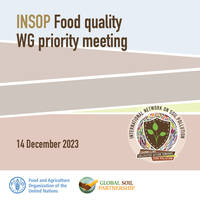
Virtual meeting | 14 December 2023 | READ MORE
INSOP Assessment WG meeting on SOP's for pesticides and soil pollutant threshold values

Virtual meeting | 16 November 2023 | READ MORE
International Network on Soil Pollution (INSOP) annual meetings
INSOP-INFA joint meeting on fertilizer quality assessment
INSOP meeting on national legal instruments for the prevention, monitoring and/or remediation of soil pollution

Virtual meeting | November 29 2023 | READ MORE
INSOP News
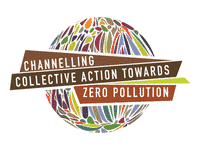
Read the latest INSOP bulletins:
Geographical distribution of INSOP members
Related activities
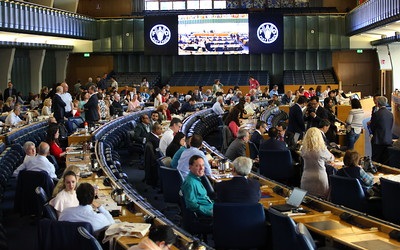
Global Symposium on Soil Pollution
2-4 May 2018, FAO headquarters
The Symposium was attended by more than 500 participants from 100 countries, including member states, academia, the private sector as well as scientists and land users working on soil pollution and related fields.

Plan of Action - GSOP18
Symposium Outcome document
The recommendations presented in the document support policies and actions that enhance the prevention, minimization and remediation of soil pollution through sustainable soil management.
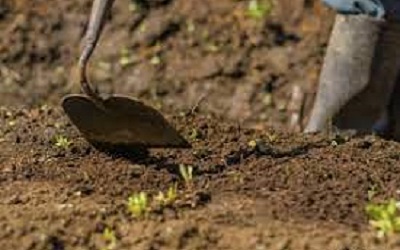
Open International Forum-Webinar
8 Nov 2022, 13:00-16:00 CET
This webinar, organized on the grounds of the Russian Timiryazev State Agrarian University will open a discussion on environmental regulation of the quality of phosphate fertilizers.

INSOP LAUNCH
TThe International Network on Soil Pollution (INSOP) was launched on 22 April 2022 at a virtual event, as part of FAO’s observance of International Mother Earth Day. Read more on the launch event.
Related publications
Communication material
Soil pollution - Be the solution to soil pollution: Campaign material (World Soil Day 2018 and Global Symposium on Soil Pollution)

Be the solution to soil pollution
Over thousands of years of human activities have left a legacy of polluted soils worldwide.
Other languages: Italian
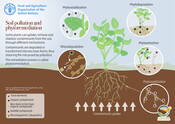
Soil pollution and phytoremediation
Some plants can uptake, remove and stabilize contaminants from the soil, through different mechanisms.
Impacts of soil pollution on key soil functions
Soil pollution causes a chain of degradation processes in soil, jeopardizing its ability to provide ecosystem services.
Pollution-induced changes in the functioning of soil ecosystems
Mobile soil fauna often uses an avoidance strategy, reducing the first steps of litter decomposition in heavily polluted soils.
Economic losses due to soil pollution
Soil pollution entails direct remediation and management costs ranging from thousands to billions of dollars per year, depending on the extent and type of contaminants.
Soil pollution jeopardizes the achievement of most of the SDGs
The prevention, control, and remediation of soil pollution are fundamental if we want to implement the 2030 Agenda for Sustainable Development.

Impact of soil contaminants on human health
Contaminants in soil have widespread effects on organs and systems, producing a wide variety of health outcomes, from acute to chronic diseases, leading to severe development issues, changes in bodily functions, and premature death.
Contaminants tranfer to the food chain
Contaminated plants and soil organisms lead to potentially hazardous accumulations in animals higher in the food web such as grazing animals, birds and ultimately transferred to humans.
Soil pollution, a hidden reality
This poster presents in a nutshell the sources, degradation processes and effects of soil pollution on the environment, human health and food safety and security.
Other languages: Thai
Soil pollution is borderless
Soil pollution is a borderless often invisible threat whose presence and effects are present in every corner of the globe.
Soil pollution postcards
Videos and animations
|
7 things you can do to stop soil pollution Let's be the solution to stop soil pollution! |
|
How can you be the solution to soil pollution? Even through your small actions you can contribute to a big goal, to #StopSoilPollution. Reduce, reuse and recycle can help you, your community by improving your health and the health of our soils. Short version: English |
|
Soil Pollution, a hidden reality Soil is a complex growing habitat that remains productive only when it is cared for and nurtured. Combating and addressing soil pollution means assessing and minimizing the risks for food security, human health and the environment. |







